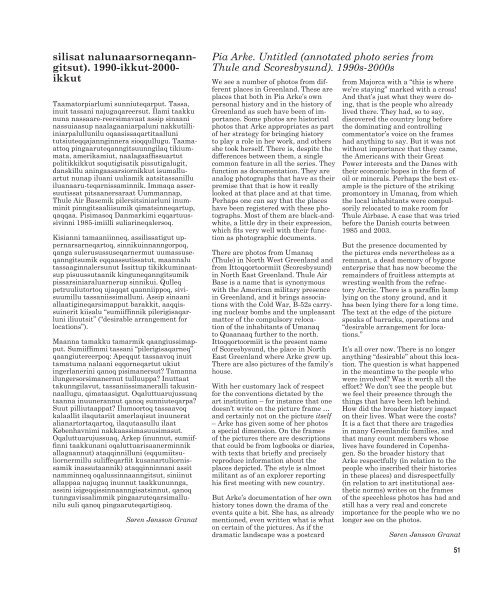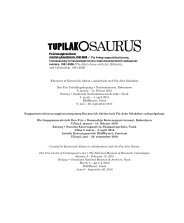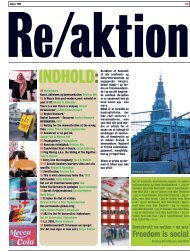tupilakosaurus - Print matters!
tupilakosaurus - Print matters!
tupilakosaurus - Print matters!
You also want an ePaper? Increase the reach of your titles
YUMPU automatically turns print PDFs into web optimized ePapers that Google loves.
silisat nalunaarsorneqanngitsut).1990-ikkut-2000ikkut<br />
Taamatorpiarlumi sunniuteqarput. Tassa,<br />
inuit tassani najugaqareersut. Ilami taakku<br />
nuna nassaare-reersimavaat assip sinaani<br />
nassuiaasup naalagaaniarpaluni nakkutilliiniarpalullunilu<br />
oqaasissaqartitaalluni<br />
tutsiuteqqajannginnera sioqqullugu. Taamaattoq<br />
pingaaruteqanngitsuunngilaq tikiummata,<br />
amerikamiut, naalagaaffissuartut<br />
politikkikkut soqutigisatik pissutigalugit,<br />
danskillu aningaasarsiornikkut isumalluartut<br />
nunap iluani uuliamik aatsitassanillu<br />
iluanaaru-teqarnissaminnik. Immaqa assersuutissat<br />
pitsaanersaraat Uummannap,<br />
Thule Air Basemik pilersitsiniarluni inumminit<br />
pinngitsaaliisumik qimatsinneqartup,<br />
qaqqaa. Pisimasoq Danmarkimi eqqartuussivinni<br />
1985-imiilli suliarineqalersoq.<br />
Kisianni tamaaniinneq, assilissatigut uppernarsarneqartoq,<br />
sinnikuinnanngorpoq,<br />
qanga sulerusussuseqarnermut uumassuseqanngitsumik<br />
eqqaassutissatut, maannalu<br />
tassaaginnalersunut Issittup tikikkuminaatsup<br />
pisuussutaanik kinguneqanngitsumik<br />
pissarsiniaraluarnerup sinnikui. Qulleq<br />
petruuliutortoq ujaqqat qaanniippoq, sivisuumillu<br />
tassaniissimalluni. Assip sinaani<br />
allaatigineqarsimapput barakkit, aaqqissuinerit<br />
kiisalu “sumiiffinnik pilerigisaqarluni<br />
iliuutsit” (“desirable arrangement for<br />
locations”).<br />
Maanna tamakku tamarmik qaangiussimapput.<br />
Sumiiffimmi tassani “pilerigisaqarneq”<br />
qaangiutereerpoq: Apeqqut tassaavoq inuit<br />
tamatuma nalaani eqqorneqartut ukiut<br />
ingerlanerini qanoq pisimanersut? Tamanna<br />
ilungersorsimanernut tulluuppa? Inuttaat<br />
takunngilavut, tassaniissimaneralli takusinnaallugu,<br />
qimataasigut. Oqaluttuarujussuaq<br />
taanna inuunerannut qanoq sunniuteqarpa?<br />
Suut pilliutaappat? Ilumoortoq tassaavoq<br />
kalaallit ilaqutariit amerlaqisut inuunerat<br />
alianartortaqartoq, ilaqutaasullu ilaat<br />
Københavnimi nakkaassimasuusimasut.<br />
Oqaluttuarujussuaq, Arkep (inunnut, sumiiffinni<br />
taakkunani oqaluttuarisaanerminnik<br />
allagaannut) ataqqinnilluni (eqqumiitsuliornermillu<br />
suliffeqarfiit kusanartuliornissamik<br />
inassutaannik) ataqqinninnani assit<br />
namminneq oqalussinnaanngitsut, siniinut<br />
allappaa najugaq inunnut taakkununnga,<br />
assini isigeqqissinnaanngisatsinnut, qanoq<br />
tunngavissalimmik pingaaruteqarsimallunilu<br />
suli qanoq pingaaruteqartigisoq.<br />
Søren Jønsson Granat<br />
Pia Arke. Untitled (annotated photo series from<br />
Thule and Scoresbysund). 1990s-2000s<br />
We see a number of photos from different<br />
places in Greenland. These are<br />
places that both in Pia Arke’s own<br />
personal history and in the history of<br />
Greenland as such have been of importance.<br />
Some photos are historical<br />
photos that Arke appropriates as part<br />
of her strategy for bringing history<br />
to play a role in her work, and others<br />
she took herself. There is, despite the<br />
differences between them, a single<br />
common feature in all the series. They<br />
function as documentation. They are<br />
analog photographs that have as their<br />
premise that that is how it really<br />
looked at that place and at that time.<br />
Perhaps one can say that the places<br />
have been registered with these photographs.<br />
Most of them are black-andwhite,<br />
a little dry in their expression,<br />
which fits very well with their function<br />
as photographic documents.<br />
There are photos from Umanaq<br />
(Thule) in North West Greenland and<br />
from Ittoqqortoormiit (Scoresbysund)<br />
in North East Greenland. Thule Air<br />
Base is a name that is synonymous<br />
with the American military presence<br />
in Greenland, and it brings associations<br />
with the Cold War, B-52s carrying<br />
nuclear bombs and the unpleasant<br />
matter of the compulsory relocation<br />
of the inhabitants of Umanaq<br />
to Quaanaaq further to the north.<br />
Ittoqqortoormiit is the present name<br />
of Scoresbysund, the place in North<br />
East Greenland where Arke grew up.<br />
There are also pictures of the family’s<br />
house.<br />
With her customary lack of respect<br />
for the conventions dictated by the<br />
art institution – for instance that one<br />
doesn’t write on the picture frame …<br />
and certainly not on the picture itself<br />
– Arke has given some of her photos<br />
a special dimension. On the frames<br />
of the pictures there are descriptions<br />
that could be from logbooks or diaries,<br />
with texts that briefly and precisely<br />
reproduce information about the<br />
places depicted. The style is almost<br />
militant as of an explorer reporting<br />
his first meeting with new country.<br />
But Arke’s documentation of her own<br />
history tones down the drama of the<br />
events quite a bit. She has, as already<br />
mentioned, even written what is what<br />
on certain of the pictures. As if the<br />
dramatic landscape was a postcard<br />
from Majorca with a “this is where<br />
we’re staying” marked with a cross!<br />
And that’s just what they were doing,<br />
that is the people who already<br />
lived there. They had, so to say,<br />
discovered the country long before<br />
the dominating and controlling<br />
commentator’s voice on the frames<br />
had anything to say. But it was not<br />
without importance that they came,<br />
the Americans with their Great<br />
Power interests and the Danes with<br />
their economic hopes in the form of<br />
oil or minerals. Perhaps the best example<br />
is the picture of the striking<br />
promontory in Umanaq, from which<br />
the local inhabitants were compulsorily<br />
relocated to make room for<br />
Thule Airbase. A case that was tried<br />
before the Danish courts between<br />
1985 and 2003.<br />
But the presence documented by<br />
the pictures ends nevertheless as a<br />
remnant, a dead memory of bygone<br />
enterprise that has now become the<br />
remainders of fruitless attempts at<br />
wresting wealth from the refractory<br />
Arctic. There is a paraffin lamp<br />
lying on the stony ground, and it<br />
has been lying there for a long time.<br />
The text at the edge of the picture<br />
speaks of barracks, operations and<br />
“desirable arrangement for locations.”<br />
It’s all over now. There is no longer<br />
anything “desirable” about this location.<br />
The question is what happened<br />
in the meantime to the people who<br />
were involved? Was it worth all the<br />
effort? We don’t see the people but<br />
we feel their presence through the<br />
things that have been left behind.<br />
How did the broader history impact<br />
on their lives. What were the costs?<br />
It is a fact that there are tragedies<br />
in many Greenlandic families, and<br />
that many count members whose<br />
lives have foundered in Copenhagen.<br />
So the broader history that<br />
Arke respectfully (in relation to the<br />
people who inscribed their histories<br />
in these places) and disrespectfully<br />
(in relation to art institutional aesthetic<br />
norms) writes on the frames<br />
of the speechless photos has had and<br />
still has a very real and concrete<br />
importance for the people who we no<br />
longer see on the photos.<br />
Søren Jønsson Granat<br />
51




